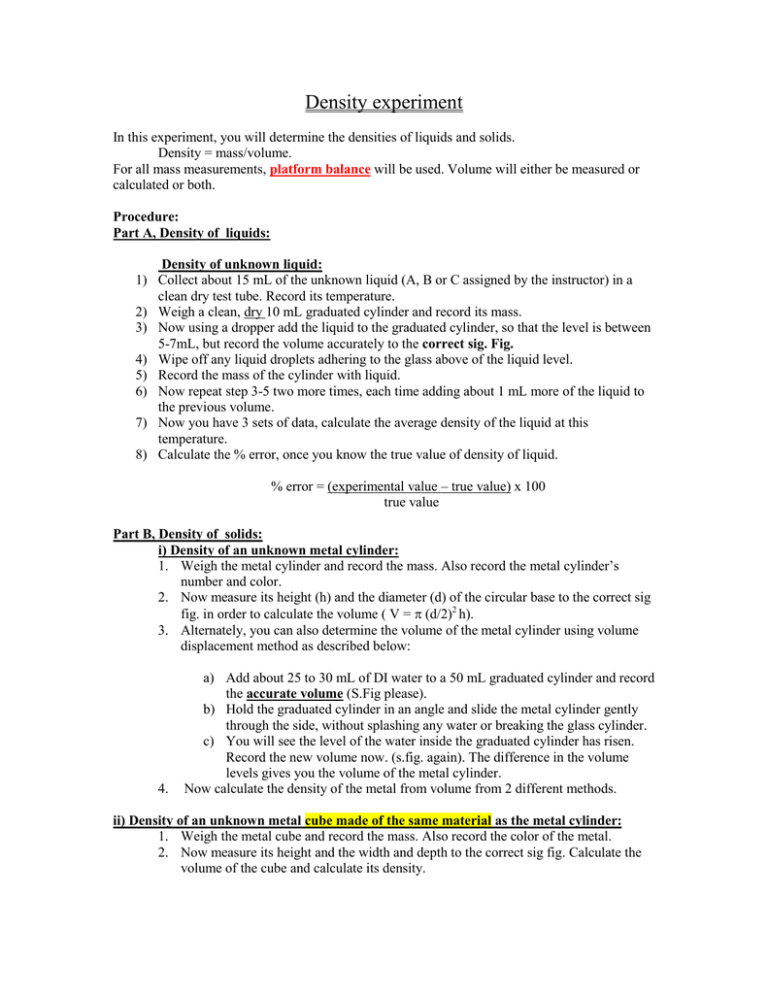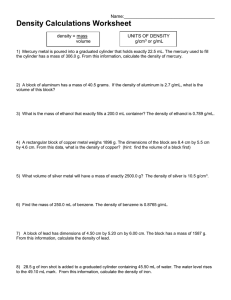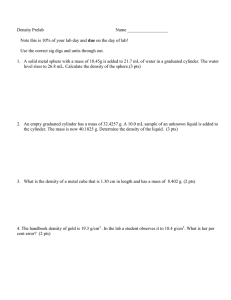Density experiment
advertisement

Density experiment In this experiment, you will determine the densities of liquids and solids. Density = mass/volume. For all mass measurements, platform balance will be used. Volume will either be measured or calculated or both. Procedure: Part A, Density of liquids: Density of unknown liquid: 1) Collect about 15 mL of the unknown liquid (A, B or C assigned by the instructor) in a clean dry test tube. Record its temperature. 2) Weigh a clean, dry 10 mL graduated cylinder and record its mass. 3) Now using a dropper add the liquid to the graduated cylinder, so that the level is between 5-7mL, but record the volume accurately to the correct sig. Fig. 4) Wipe off any liquid droplets adhering to the glass above of the liquid level. 5) Record the mass of the cylinder with liquid. 6) Now repeat step 3-5 two more times, each time adding about 1 mL more of the liquid to the previous volume. 7) Now you have 3 sets of data, calculate the average density of the liquid at this temperature. 8) Calculate the % error, once you know the true value of density of liquid. % error = (experimental value – true value) x 100 true value Part B, Density of solids: i) Density of an unknown metal cylinder: 1. Weigh the metal cylinder and record the mass. Also record the metal cylinder’s number and color. 2. Now measure its height (h) and the diameter (d) of the circular base to the correct sig fig. in order to calculate the volume ( V = (d/2)2 h). 3. Alternately, you can also determine the volume of the metal cylinder using volume displacement method as described below: 4. a) Add about 25 to 30 mL of DI water to a 50 mL graduated cylinder and record the accurate volume (S.Fig please). b) Hold the graduated cylinder in an angle and slide the metal cylinder gently through the side, without splashing any water or breaking the glass cylinder. c) You will see the level of the water inside the graduated cylinder has risen. Record the new volume now. (s.fig. again). The difference in the volume levels gives you the volume of the metal cylinder. Now calculate the density of the metal from volume from 2 different methods. ii) Density of an unknown metal cube made of the same material as the metal cylinder: 1. Weigh the metal cube and record the mass. Also record the color of the metal. 2. Now measure its height and the width and depth to the correct sig fig. Calculate the volume of the cube and calculate its density. Pre lab questions: 1. A metal cylinder with 26.0 mm diameter and 75.0 mm height has a density of 8.60 g/mL . Calculate its mass. 2. A metal sphere weighing 18.48 g is added to 20.00 mL of water in a graduated cylinder. If the density of the metal is 4.50 g/mL, what will be new level of water in the graduated cylinder? 3. Could you use volume displacement method with water for finding the volume of a wood cube, assuming the cube can fit into the cylinder? Explain why or why not. 4. Using volume displacement method, how will you find the volume of an irregularly shaped object that would dissolve in water? DATA and CALCULATIONS: Part A : Density of unknown liquid _____ (A/B/C) Temperature of liquid : _____________ Mass of empty graduated cylinder: _________ Trial 1 Trial 2 Trial 3 Volume of liquid (mL) Mass of liquid + graduated cylinder (g) Mass of liquid alone (g) Density of liquid (g/mL) Density from literature % error Show below all the calculations for trial 1: Part B, Density of solids: i) Density of an unknown metal cylinder : #___ ; color : _____ Mass of metal cylinder (g) Diameter Height (cm) (cm) Volume (cm3) Density of metal (g/cm3) Density % error from literature (g/cm3) Show calculations: Volume of water before Volume of water dropping metal after immersing cylinder (mL) the metal cylinder (mL) Show calculations: Volume of metal cylinder (mL) Density of metal (g/cm3) % error ii) Density of an unknown metal cube: #___ ; color : _____ Mass of Depth metal (cm) cube (g) Work: Height (cm) Width (cm) Volume (cm3) Density of metal (g/cm3) Density % from error literature (g/cm3)






